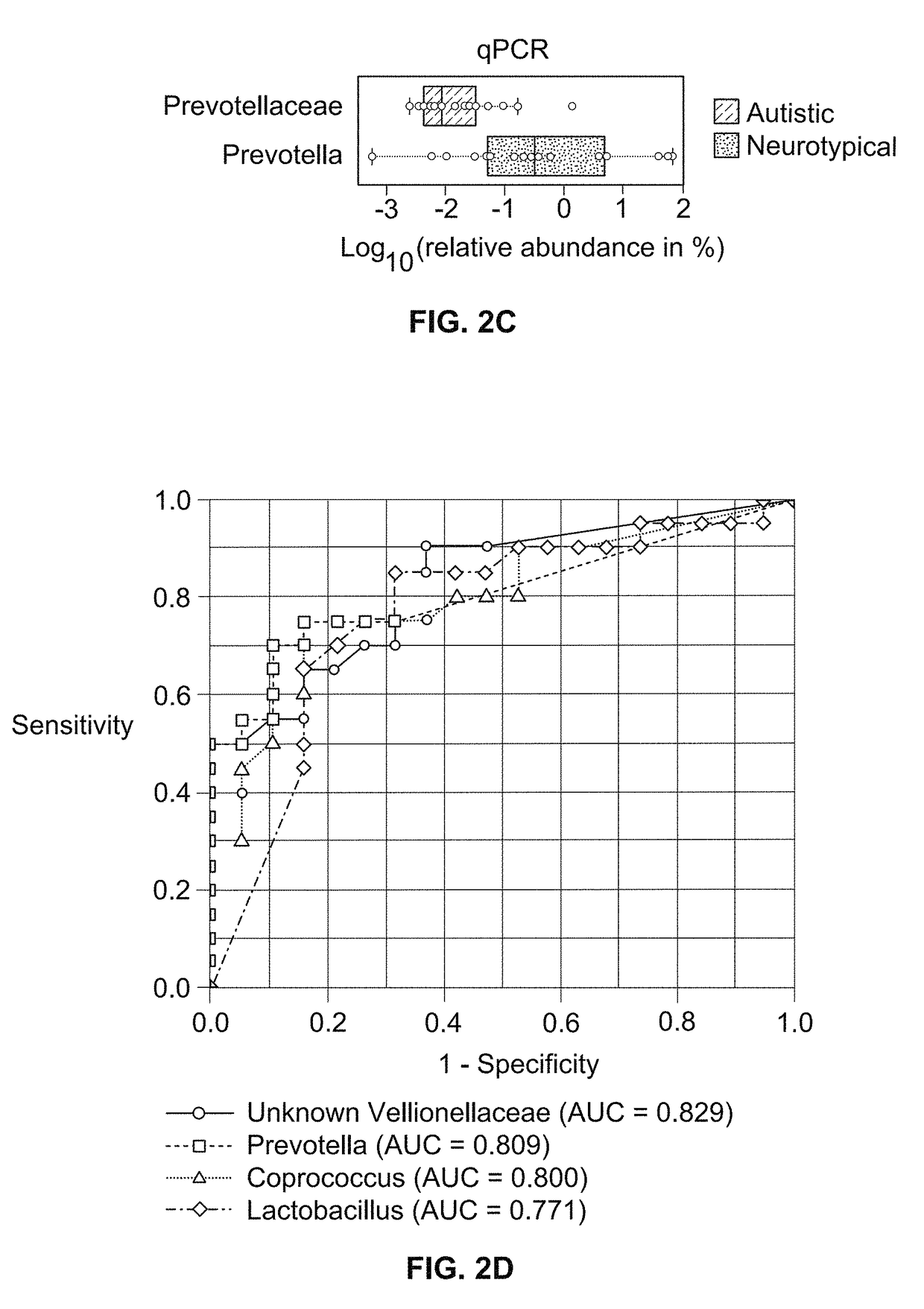Microbiome markers and therapies for autism spectrum disorders
a technology of microorganisms and markers, applied in the field of microorganisms, neurology, nutritional physiology, can solve the problems of gi problems, exacerbate other disorders or symptoms, and the subject and his family face difficulties in treatmen
- Summary
- Abstract
- Description
- Claims
- Application Information
AI Technical Summary
Benefits of technology
Problems solved by technology
Method used
Image
Examples
example 1
Subject Recruitment and Characteristics
[0082]Fifty-six (56) applicants, which included thirty (30) neurotypical and twenty-six (26) autistic subjects ranging from 3 to 15 years of age, were enrolled. Neurotypical children that were first-degree relatives of children with ASD were excluded. The twenty-six children with Autism Spectrum Disorders (ASD) were assessed with the Autism Diagnostics Interview Revised (ADI-Revised) and the Autism Diagnostics Observation Schedule (ADOS) to confirm their autism diagnosis. The Autism Treatment Evaluation Checklist (ATEC) and Pervasive Developmental Disorder Behavior Inventory (PDD-BI) assessments were also used to evaluate autism severity. The ATEC consists of four subscales: (1) speech / language / communication; (2) sociability; (3) sensory / cognitive awareness; and (4) health / physical behavior. The total ATEC score is the sum of the scores from each subscale. For PDD-BI scores, a modified “Autism Composite” was determined based on the addition of ...
example 2
Sample Collection and DNA Extraction
[0086]Parents collected and froze a single fecal sample from each subject. Frozen fecal samples were shipped overnight to Arizona State University with a cold pack, and stored in a temperature of about 80° C. until DNA extraction. Genomic DNA was isolated from human stool samples (wet weight: about 1.0 g) using QIAamp DNA Stool Mini Kit (Qiagen, CA) following the manufacturer's instructions. The quantity and quality of DNA were assessed by measuring the absorbance at about 260 nm and about 280 nm using a NanoDrop ND-1000 spectrophotometer (NanoDrop Technology, Rockland, Del.) and agarose gel (about 1%, w / v) electrophoresis.
example 3
Pyrosequencing Analysis of Community Structures
[0087]Extracted genomic DNA was processed at the Research and Testing Laboratory (Lubbock, Tex.), where the bacterial tag-encoded FLX amplicon pyrosequencing (bTEFAP) was performed by the Genome Sequencer FLX-Titanium System and its Titanium protocol (Roche, Indianapolis, Ind.), as described in Sun et al., in “Tag-Encoded FLX Amplicon Pyrosequencing for the Elucidation of Microbial and Functional Gene Diversity in Any Environment” METHS. MOLEC. BIO. 129, which is hereby incorporated by reference for its methods and analysis of pyrosequencing. Bacterial primers 104F (5′-GGCGVACGGGTGAGTAA-3′) (SEQ ID NO:1) and 530R (5′-CCGCNGCNGCTGGCAC-3′) (SEQ ID NO:2) were used to amplify the combined V2 and V3 regions of 16S rRNA, and the amplicon was sequenced by the procedure described in Wolcott et al., “Evaluation of the bacterial diversity among and within individual venous leg ulcers using bacterial tag-encoded FLX and Titanium amplicon pyroseque...
PUM
| Property | Measurement | Unit |
|---|---|---|
| sequence similarity threshold | aaaaa | aaaaa |
| sequence similarity threshold | aaaaa | aaaaa |
| sequence similarity threshold | aaaaa | aaaaa |
Abstract
Description
Claims
Application Information
 Login to View More
Login to View More - R&D
- Intellectual Property
- Life Sciences
- Materials
- Tech Scout
- Unparalleled Data Quality
- Higher Quality Content
- 60% Fewer Hallucinations
Browse by: Latest US Patents, China's latest patents, Technical Efficacy Thesaurus, Application Domain, Technology Topic, Popular Technical Reports.
© 2025 PatSnap. All rights reserved.Legal|Privacy policy|Modern Slavery Act Transparency Statement|Sitemap|About US| Contact US: help@patsnap.com



